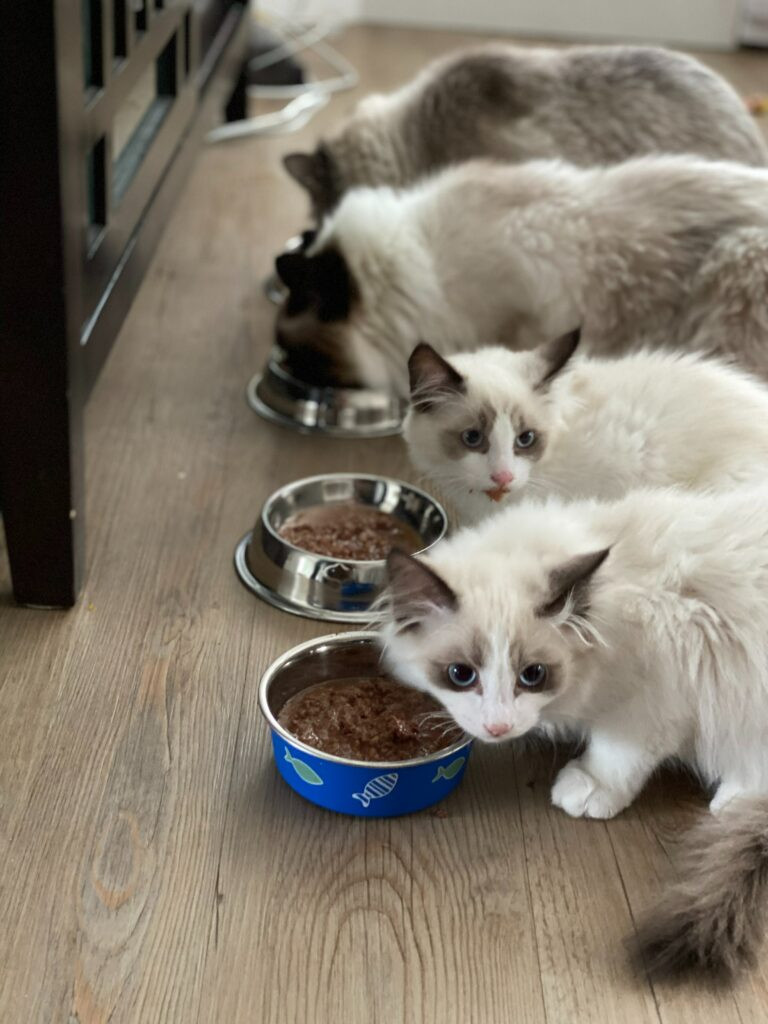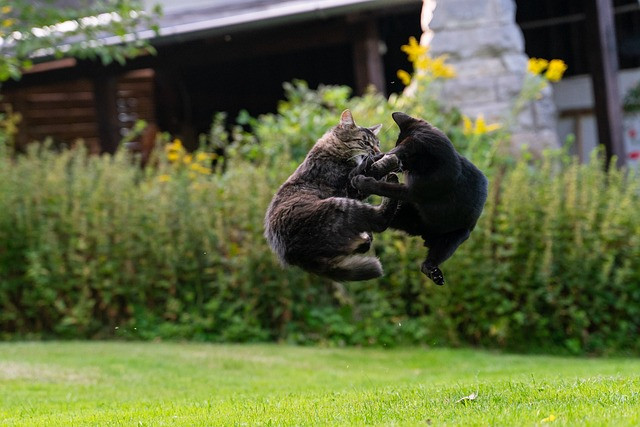Living with multiple cats can be a rewarding experience, filled with purrs, cuddles, and the joy of watching feline companions entertain each other. However, the harmony can be disrupted when cat fights erupt. Even cats that have coexisted peacefully for years can suddenly become adversaries under certain circumstances. Understanding why “Cat Fights Cat” situations arise and how to manage them is crucial for maintaining a peaceful multi-cat household.
You might witness the initial trigger or the first actual fight, or you may be completely unaware of what sparked the conflict. Sometimes, the cause might be something seemingly insignificant, easily overlooked as a potential source of feline discord.
A common scenario that triggers “cat fights cat” incidents often involves a veterinary visit. Imagine this: two cats living in harmony for years. One cat goes to the veterinarian for a routine check-up, a dental procedure, or any other medical reason. Upon returning home, this cat may act slightly different, which is understandable given the stress of a vet visit. (Remember, regular veterinary check-ups are vital for your cat’s well-being).
Initially, the cats might seem fine with each other, or conflict might arise immediately. But inevitably, a fight breaks out, and you are forced to intervene and stop the cat fight. This moment can fracture their relationship. Cats that once lounged and played together might now become unable to share the same space without conflict. Even when they are in the same room, the atmosphere can become tense, and the cats may appear more stressed than before, their previous easygoing dynamic completely altered.
 Four white cats eat out of four bowls.
Four white cats eat out of four bowls.
A peaceful multi-cat mealtime, showcasing feline harmony when cats get along. Photo by Fernando Jorge.
Witnessing once-friendly cats turn into adversaries is distressing for cat owners. The desire to restore their bond and eliminate the constant worry of potential clashes becomes paramount. You yearn for the days when your cats were buddies, not combatants, and wonder if that peaceful existence is still achievable.
Unpacking the Reasons Behind “Cat Fights Cat” Scenarios
While numerous factors can lead to “cat fights cat” situations, the scenario described above often stems from a phenomenon called non-recognition aggression, where cats fail to recognize each other. This might seem perplexing to humans, but scent plays a pivotal role in feline recognition. When a cat returns from the vet smelling unfamiliar or behaving differently due to stress or medication, their housemate might perceive them as a stranger, triggering aggression.
Cats are inherently territorial animals, and unfamiliar cats are often viewed with suspicion and hostility. A cat, sensing a perceived threat in their territory, may act defensively. The returning cat, possibly confused and stressed, might misinterpret this aggression, leading to a cycle of fear and hostility whenever they encounter each other.
In other cases of “cat fights cat”, the cats may have never truly established a harmonious relationship from the outset. This could be due to personality clashes or an improper initial introduction process. Fear and anxiety can become ingrained, and each fight reinforces these negative associations.
 Two cats fighting while flying through the air.
Two cats fighting while flying through the air.
An intense “cat fights cat” scene, illustrating a serious feline conflict, not playful sparring. Photo by René Schindler.
Furthermore, “cat fights cat” can also be triggered by misdirected aggression. If a frightening event occurs, like a loud noise, and a cat is near another cat, they may misattribute their fear to the other cat. This can lead to an aggressive outburst directed towards their feline companion as a way to displace their anxiety.
Navigating “Cat Fights Cat”: Immediate Actions and Long-Term Solutions
When “cat fights cat” incidents occur, the immediate instinct is to restore peace and normalcy within your home. While some minor skirmishes might resolve themselves without intervention, persistent fighting usually requires a more structured approach. To guide your cats back to a friendly relationship, a process known as reintroduction is often necessary.
Reintroduction Techniques for “Cat Fights Cat” Resolution
Reintroductions are systematic methods designed to help cats relearn that the other cat is not a threat and can even be associated with positive experiences. While often effective when implemented correctly, reintroductions can be a lengthy process, sometimes taking months to achieve a semblance of normalcy. The more negative interactions cats have, the more challenging the reintroduction process can become. In some unfortunate instances, the conflict may be irreconcilable, and rehoming one cat might be the most compassionate option.
Reintroduction essentially mirrors the initial process of introducing cats for the first time, but with greater precision and a slower pace. Complete separation of the cats is crucial throughout the reintroduction, except during controlled interaction sessions.
The demanding nature of reintroductions, both in terms of time and emotional investment, can be overwhelming for cat owners. Even with reliable guides, navigating this process alone can be tough. Fortunately, expert guidance is available. Reintroduction strategies are frequently sought after solutions for “cat fights cat”, making it a primary reason why cat owners seek professional help for their feline behavior issues. If you are committed to resolving “cat fights cat” in your home and willing to dedicate the effort, professional assistance can significantly increase your chances of success.
Exploring Alternatives to Reintroduction for “Cat Fights Cat”
If a full reintroduction seems daunting initially, several alternative strategies can be attempted to mitigate “cat fights cat”. These options have varying degrees of success, but may be worth exploring. Seeking personalized advice for your specific situation is always recommended. You can schedule a behavior consultation to discuss your “cat fights cat” challenges and determine the most appropriate course of action.
One commonly suggested remedy involves pheromone diffusers. While generally harmless, their effectiveness in resolving serious “cat fights cat” is often limited. While you can try them, manage your expectations regarding their impact.
Addressing the Root Cause of “Cat Fights Cat”
Identifying and resolving the underlying cause of “cat fights cat” is paramount. Attempt to address the problem directly, avoiding methods that scare your cats and potentially worsen their fear of each other. For example, if resource competition over a favorite cat tower is fueling the fights, providing a second cat tree can alleviate the tension. While this might prevent further conflicts, repairing any damage to their relationship might still require additional effort.
Temporary separation can also be a useful diagnostic tool and a short-term solution for “cat fights cat”. Separating the cats for a few hours or even a few days, ensuring all their needs are met in their separate spaces, can provide a break from the conflict. Crucially, they should not be able to see each other during this separation. Using an under-door draft guard to prevent paw-swiping under doors or window film to block visual contact through windows might be necessary to ensure complete separation.
What to Avoid When Dealing with “Cat Fights Cat”
Certain approaches to “cat fights cat” are counterproductive and should be avoided. The outdated advice of letting cats “fight it out” is detrimental and dangerous. This approach is not only ineffective in resolving conflict but also carries a significant risk of injury to your cats. Active intervention and guided strategies are always preferable to uncontrolled fighting.
Another common, yet misguided, suggestion is to feed cats near each other to create positive associations. However, this is not supported by current feline behavior understanding (and is absent from the recent AAFP guidelines on intercat tension). In fact, cats generally prefer to eat separately, and forced proximity during meals can actually increase stress and tension, potentially exacerbating “cat fights cat”. Cats might tolerate eating near each other simply because of their desire to eat, but underlying animosity can persist. It’s best to avoid this tactic.
When “cat fights cat” are actively occurring, your priority is to safely break up the fight without putting yourself at risk of injury. Never place your hands directly between fighting cats, as this is a surefire way to get bitten by a cat.
Hope for Harmony After “Cat Fights Cat”
“Is there hope for my fighting cats?” This is a frequent question from concerned cat owners seeking help for “cat fights cat”. While various factors influence the likelihood of cats coexisting peacefully, hope exists in many situations, provided realistic expectations and commitment to the process. Rapid resolution is rarely possible, and patience is key. Sometimes, the situation will improve naturally over time. More often, however, active intervention is necessary. With patience and the right strategies, transforming a house filled with the hiss of cats into a harmonious home is often achievable.
Need Expert Help with Your “Cat Fights Cat” Situation?
Schedule a Consultation Today to get personalized guidance and resolve “cat fights cat” in your home.
